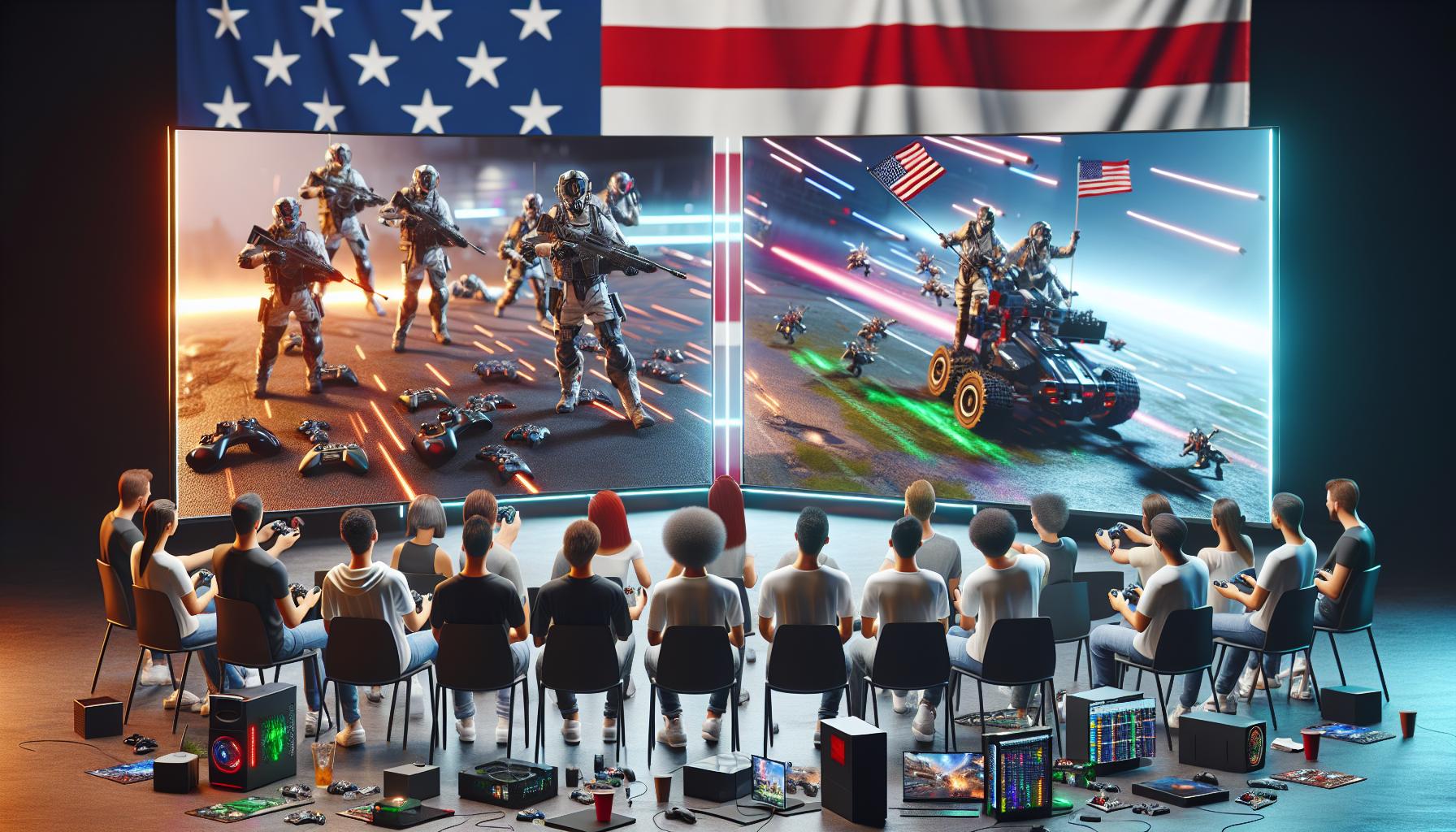As someone who’s been following the gaming industry for over two decades, I’ve witnessed the incredible evolution of video game streaming. The journey from simple gameplay recordings to live interactive broadcasts has transformed how we experience and share gaming content.
I remember when Justin.tv launched in 2007, marking the beginning of what would become the modern streaming era. While it wasn’t exclusively for gaming, this platform laid the groundwork for Twitch.tv and other specialized streaming services that would follow. Today’s billion-dollar streaming industry emerged from these humble beginnings, creating new career opportunities and reshaping how we consume gaming content.
Key Takeaways
- Video game streaming began in 2007 with Justin.tv, which later evolved into Twitch.tv in 2011, revolutionizing how people consume gaming content
- The early period (2007-2010) saw rapid growth, with Justin.tv reaching 1 million users by 2008 and establishing fundamental features like viewer interaction and gameplay commentary
- Twitch’s launch in 2011 marked a turning point, growing to 3.2 million monthly viewers and introducing key features like partner programs and subscription systems
- The industry saw major technological advances from 2007-2023, including improvements in internet infrastructure, streaming quality (up to 4K/60fps), and reduced latency
- Streaming platforms created new career opportunities, generating over $4.5B annually through subscriptions and enabling jobs like professional streamers and content managers
- Today’s streaming landscape is dominated by Twitch (72.3% market share), followed by YouTube Gaming and Facebook Gaming, in a $71 billion industry
The Early Days of Video Game Streaming (2007-2010)
Live video game streaming gained momentum in 2007 with the emergence of novel broadcasting platforms. The transformative period between 2007 and 2010 established the foundations for modern gaming content creation.
Justin.tv and the Birth of Live Streaming
Justin.tv launched its beta platform in March 2007, introducing the concept of “lifecasting” through 24/7 broadcasts. The platform expanded in October 2007 to include user-created channels, leading to 60+ gaming channels by December 2007. Justin.tv’s growth accelerated after implementing partner programs in 2009, allowing content creators to earn revenue through advertisements.
Key Justin.tv Milestones:
- Reached 1 million registered users by 2008
- Introduced mobile streaming capabilities in 2009
- Developed HD streaming support in 2010
- Created dedicated gaming section in late 2010
Rise of Gaming Content Creators
Gaming content creators established new broadcasting formats during this period, transforming casual gameplay into engaging entertainment. Notable developments included:
Early Streaming Innovations:
- Implemented viewer interaction through chat systems
- Created scheduled streaming programs
- Developed gameplay commentary techniques
- Established speedrunning communities
- Organized multiplayer streaming events
| Year | Active Streamers | Average Viewers | Popular Games |
|---|---|---|---|
| 2007 | 100+ | 50-100 | World of Warcraft |
| 2008 | 1,000+ | 100-500 | Call of Duty 4 |
| 2009 | 3,000+ | 500-2,000 | League of Legends |
| 2010 | 10,000+ | 2,000-5,000 | StarCraft II |
The Twitch Revolution

Twitch emerged as a dedicated gaming platform in 2011 transforming video game streaming into a mainstream phenomenon. The platform’s rapid growth redefined content creation standards establishing new benchmarks for gaming entertainment.
From Justin.tv Gaming to Twitch
Justin.tv’s gaming section expanded exponentially reaching 3.2 million unique monthly viewers by June 2011. The success prompted the company to launch Twitch.tv as a separate platform on June 6 2011 focusing exclusively on gaming content. Key developments included:
- Introduced partnered channels program offering revenue sharing opportunities
- Created custom chat emotes enhancing viewer engagement
- Launched TwitchCon in 2015 connecting streamers with their communities
- Added subscription tiers expanding monetization options
| Year | Monthly Active Users | Hours Watched |
|---|---|---|
| 2011 | 3.2 million | 45 million |
| 2012 | 20 million | 148 million |
| 2013 | 45 million | 322 million |
Building the First Major Streaming Platform
Twitch established core features that defined modern streaming platforms:
- Implemented low-latency streaming reducing delay to under 10 seconds
- Created integrated donation systems enabling direct viewer support
- Developed channel moderation tools ensuring content quality
- Added mobile streaming apps expanding accessibility
The platform’s infrastructure improvements supported:
- 100 million monthly viewers by 2014
- $970 million acquisition by Amazon
- Integration with gaming consoles PS4 Xbox One
- Implementation of VOD (Video on Demand) services
By 2014 Twitch accounted for 43.6% of all live streaming traffic in North America cementing its position as the premier gaming broadcast platform.
Key Milestones in Game Streaming History

The evolution of game streaming accelerated rapidly after Twitch’s success, marked by significant platform launches and technological advancements. These developments expanded streaming accessibility and created diverse content delivery methods.
YouTube Gaming Launch
YouTube Gaming emerged in 2015 as a direct response to Twitch’s dominance, introducing features like DVR functionality for live streams and improved chat moderation tools. The platform launched with support for 60fps streaming at 1080p resolution, integrating with existing YouTube channels to reach over 1 billion active users. By 2016, YouTube Gaming had established unique features including Super Chat, channel memberships and dedicated mobile streaming apps.
| YouTube Gaming Metrics (2015-2016) | Statistics |
|---|---|
| Initial Content Creators | 25,000+ |
| Launch Day Live Streams | 10,000+ |
| Supported Games | 25,000+ |
| Average Stream Quality | 1080p/60fps |
- One-touch streaming activation
- Built-in chat overlay systems
- Mobile game capture optimization
- Cross-platform streaming capabilities
- Integrated monetization tools
| Mobile Streaming Growth (2015-2019) | Statistics |
|---|---|
| Monthly Active Streamers | 15M+ |
| Daily Mobile Stream Hours | 500,000+ |
| Average Stream Length | 45 minutes |
| Mobile Viewer Share | 35% of total |
Evolution of Streaming Technology

The technical foundation of video game streaming underwent significant transformations from 2007 to 2023, driven by advances in internet infrastructure and broadcasting capabilities. These developments enabled smoother streams, higher quality broadcasts and enhanced viewer experiences.
Improved Internet Infrastructure
Broadband penetration rates increased from 47% in 2007 to 94% in 2023, enabling widespread streaming adoption. Average internet speeds evolved from 3.6 Mbps in 2007 to 255.7 Mbps in 2023, supporting:
- 4K resolution streaming at 60 frames per second
- Multi-bitrate transcoding for different connection speeds
- Sub-second latency for real-time viewer interaction
- Content delivery networks reducing buffering by 85%
- IPv6 implementation expanding connection capacity by 340%
- OBS Studio introduced scene compositing in 2012
- XSplit added chromakey effects in 2011
- Streamlabs launched automated alerts in 2014
- Elgato capture cards enabled console streaming in 2012
- Stream Deck controllers streamlined production in 2017
| Year | Technology Milestone | Impact |
|---|---|---|
| 2012 | OBS Launch | 75% reduction in CPU usage |
| 2014 | NVENC Encoding | 40% improved stream quality |
| 2017 | WebRTC Support | Latency reduced to 200ms |
| 2020 | AV1 Codec | 50% bandwidth efficiency gain |
| 2022 | AI Upscaling | 4K streams at 1080p bandwidth |
Impact on Gaming Culture
Video game streaming transformed gaming from a solitary activity into a social entertainment phenomenon connecting millions of viewers globally. This cultural shift revolutionized how people consume gaming content interact with creators engage in competitive play.
Rise of eSports Streaming
Live streaming catalyzed the explosive growth of competitive gaming viewership. Major eSports tournaments like League of Legends World Championship reached peak concurrent viewers of 5.1 million in 2022. The accessibility of tournament broadcasts led to:
- Increased prize pools from $3.6 million in 2010 to $384 million in 2022
- Professional league formations across 15+ major game titles
- Dedicated eSports channels on streaming platforms reaching 828 million viewers
- Integration of streaming features into competitive games
- Development of spectator modes optimized for broadcast
| Year | Global eSports Viewers | Prize Money |
|---|---|---|
| 2010 | 28M | $3.6M |
| 2015 | 226M | $65.8M |
| 2020 | 495M | $192.3M |
| 2022 | 828M | $384M |
Creating New Career Opportunities
Streaming platforms opened diverse career paths in the gaming industry. Content creators established sustainable income streams through:
- Channel subscriptions generating $4.5B+ annually
- Brand partnerships valued at $2.1B in 2022
- Direct viewer donations exceeding $100M yearly
- Merchandise sales reaching $500M annually
- Professional coaching services earning $50K-$200K per year
The emergence of specialized roles includes:
- Professional streamers
- Stream managers
- Channel moderators
- Content editors
- Analytics specialists
- Broadcast technicians
- Community managers
These positions created a streaming ecosystem employing over 500,000 professionals globally by 2023.
Modern Streaming Landscape
The streaming landscape in 2024 features multiple platforms competing for market share in the $71 billion live-streaming industry. This ecosystem encompasses dedicated gaming platforms specialized streaming tools integrated social features.
Major Platforms and Competition
The current streaming market showcases distinct platform strategies:
| Platform | Market Share | Monthly Active Users | Key Features |
|---|---|---|---|
| Twitch | 72.3% | 140M | Low latency streams Squad Streaming |
| YouTube Gaming | 15.6% | 90M | VOD integration Super Chat |
| Facebook Gaming | 7.2% | 45M | Mobile integration Stars system |
| TikTok Live | 3.1% | 30M | Short-form content Gifting system |
Competition drives platform innovation through:
- Cross-platform streaming capabilities
- Enhanced monetization tools
- 4K resolution support
- AI-powered content moderation
- Interactive viewer rewards
Streaming as Entertainment
Gaming streams evolved into multi-format content:
| Content Type | Viewer Share | Growth Rate (2023) |
|---|---|---|
| Live gameplay | 45% | +23% |
| Just Chatting | 25% | +31% |
| eSports | 20% | +28% |
| Creative | 10% | +15% |
Content creators differentiate through:
- Multi-camera setups
- Custom overlay designs
- Interactive chatbots
- Scheduled programming
- Cross-platform engagement
- Virtual reality streams
- Collaborative broadcasts
- Channel memberships
- Virtual currency systems
- Exclusive emotes
- Subscription tiers
- Integrated merchandise stores
- Direct donation features
- Community challenges
Conclusion
Looking back at the incredible journey of video game streaming I can see how it’s transformed from a niche hobby into a global phenomenon. What started with Justin.tv’s simple broadcasts has evolved into a thriving $71 billion industry that’s reshaping entertainment.
The technological leaps content creator innovations and platform developments have made streaming more accessible and engaging than ever. Today’s streaming landscape offers endless opportunities for creators and viewers alike with platforms like Twitch YouTube Gaming and others constantly pushing boundaries.
I’m amazed at how video game streaming has become an integral part of gaming culture creating new careers connecting communities and turning gaming into a shared social experience. It’s clear that streaming will continue to evolve shaping the future of digital entertainment.




